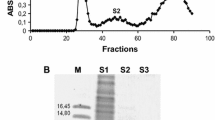Abstract
Extracts from different higher plants were screened for the ability to inhibit the growth of Penicillium roqueforti, a major contaminating species in industrial food processing. Oat (Avena sativa) seed extracts exhibited a high degree of antifungal activity and could be used directly on rye bread to prevent the formation of P. roqueforti colonies. Proteins in the oat seed extracts were fractionated by column chromatography and proteins in fractions containing antifungal activity were identified by liquid chromatography–tandem mass spectrometry (LC-MS/MS) and database searches. Identified antifungal candidates included thaumatin-like proteins, 1,3-beta-glucanase, permatin precursor, pathogenesis-related protein type 1, and chitinases of class I and II. Class I chitinase could be specifically removed from the extracts and was found to be indispensable for 50% of the P. roqueforti inhibiting activity. The purified class I chitinase has a molecular weight of approximately 34 kDa, optimal chitinase activity at pH 7, and exists as at least two basic isoforms (pI values of 7.6 and 8.0). Partial sequencing of the class I chitinase isoforms by LC-MS/MS revealed a primary structure with high similarity to class I chitinases of wheat (Triticum aestivum), barley (Hordeum vulgare), and rye (Secale cereale). Oat, wheat, barley, and rye seed extracts were compared with respect to the abundance of the class I chitinase and decrease in antifungal activity when class I chitinase is removed. We found that the oat seed class I chitinase is at least ten times more abundant than the wheat, barley, and rye homologs and that oat seed extracts are highly active toward P. roqueforti as opposed to extracts of other cereal seeds.





Similar content being viewed by others
References
Filtenborg, O., Frisvad, J. C., & Thrane, U. (1996). International Journal of Food Microbiology, 33, 85–102. doi:10.1016/0168-1605(96)01153-1.
Loon, L., & Strien, E. (1999). Physiological and Molecular Plant Pathology, 55, 85–97. doi:10.1006/pmpp.1999.0213.
Ye, X. Y., Wang, H. X., & Ng, T. B. (2000). Life Sciences, 67, 3199–3207. doi:10.1016/S0024-3205(00)00905-X.
Caruso, C., Chilosi, G., Leonardi, L., Bertini, L., Magro, P., Buonocore, V., & Caporale, C. (2001). Phytochemistry, 58, 743–750. doi:10.1016/S0031-9422(01)00226-6.
Kasprzewska, A. (2003). Cellular & Molecular Biology Letters, 8, 809–824.
Leah, R., Tommerup, H., Svendsen, I., & Mundy, J. (1991). The Journal of Biological Chemistry, 266, 1564–1573.
Taira, T., Ohnuma, T., Yamagami, T., Aso, Y., Ishiguro, M., & Ishihara, M. (2002). Bioscience, Biotechnology, and Biochemistry, 66, 970–977. doi:10.1271/bbb.66.970.
Henrissat, B., & Bairoch, A. (1993). The Biochemical Journal, 293, 781–788.
Bak-Jensen, K. S., Laugesen, S., Roepstorff, P., & Svensson, B. (2004). Proteomics, 4, 728–742. doi:10.1002/pmic.200300615.
Yamagami, T., & Funatsu, G. (1994). Bioscience, Biotechnology, and Biochemistry, 58, 322–329.
Yamagami, T., & Funatsu, G. (1993). Bioscience, Biotechnology, and Biochemistry, 57, 1854–1861.
Iseli, B., Boller, T., & Neuhaus, J. M. (1993). Plant Physiology, 103, 221–226. doi:10.1104/pp.103.1.221.
Yamagami, T., & Funatsu, G. (1996). Bioscience, Biotechnology, and Biochemistry, 60, 1081–1086.
Leah, R., Skriver, K., Knudsen, S., Ruud-Hansen, J., Raikhel, N. V., & Mundy, J. (1994). The Plant Journal, 6, 579–589. doi:10.1046/j.1365-313X.1994.6040579.x.
Keith, K., & Morrison, J. (1982). In D. Purich (Ed.), Methods in enzymology (vol. 87, pp. 405–426). London: Academic.
Shevchenko, A. (1996). Analytical Chemistry, 68, 850–858. doi:10.1021/ac950914h.
Andersen, M. D., Jensen, A., Robertus, J. D., Leah, R., & Skriver, K. (1997). The Biochemical Journal, 322, 815–822.
Song, H. K. (1996). Acta Crystallographica. Section D, Biological Crystallography, 52, 289–298. doi:10.1107/S0907444995009061.
Skadsen, R. W., Sathish, P., & Kaeppler, H. F. (2000). Plant Science, 156, 11–22. doi:10.1016/S0168-9452(00)00226-0.
Hollis, T., Honda, Y., Fukamizo, T., Marcotte, E., Day, P. J., & Robertus, J. D. (1997). Archives of Biochemistry and Biophysics, 344, 335–342. doi:10.1006/abbi.1997.0225.
Ohnuma, T., Taira, T., Yamagami, T., Aso, Y., & Ishiguro, M. (2004). Bioscience, Biotechnology, and Biochemistry, 62, 324–332. doi:10.1271/bbb.68.324.
Acknowledgements
We thank Svalöf Weibull B.V.—The Netherlands, Sejet planteforædling—Denmark, DLG—Denmark, and FAF Odense—Denmark for supplying the seeds. We are thankful for the technical excellence and practical support provided by Pia Friis Jensen. This work was supported by grants from the Danish Ministry of Food, Agriculture and Fisheries (grant number 3401-86-03-124).
Author information
Authors and Affiliations
Corresponding author
Rights and permissions
About this article
Cite this article
Sørensen, H.P., Madsen, L.S., Petersen, J. et al. Oat (Avena sativa) Seed Extract as an Antifungal Food Preservative Through the Catalytic Activity of a Highly Abundant Class I Chitinase. Appl Biochem Biotechnol 160, 1573–1584 (2010). https://doi.org/10.1007/s12010-009-8557-4
Received:
Accepted:
Published:
Issue Date:
DOI: https://doi.org/10.1007/s12010-009-8557-4




